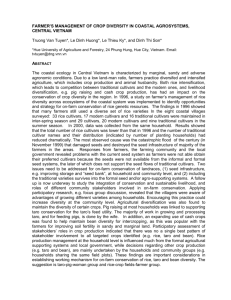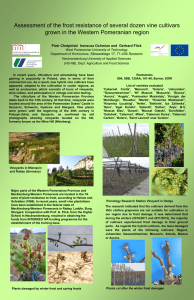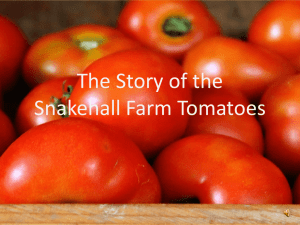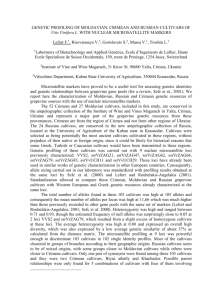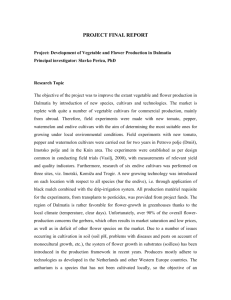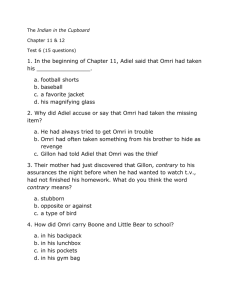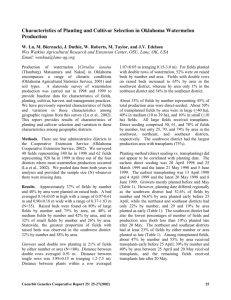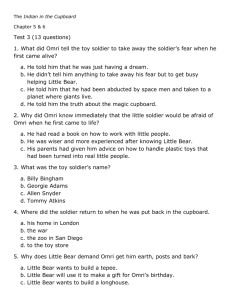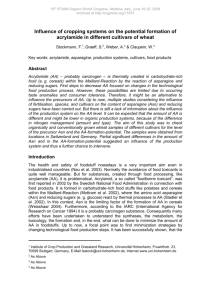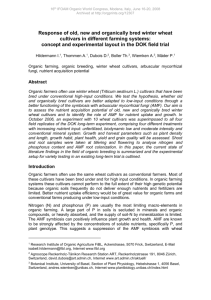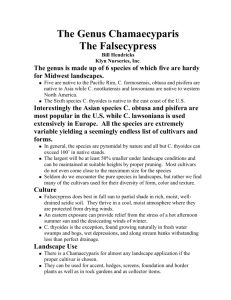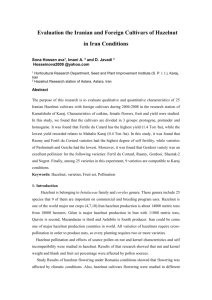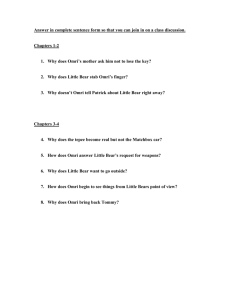Organic Vegetable Production - Sustainable Agriculture In Oklahoma
advertisement
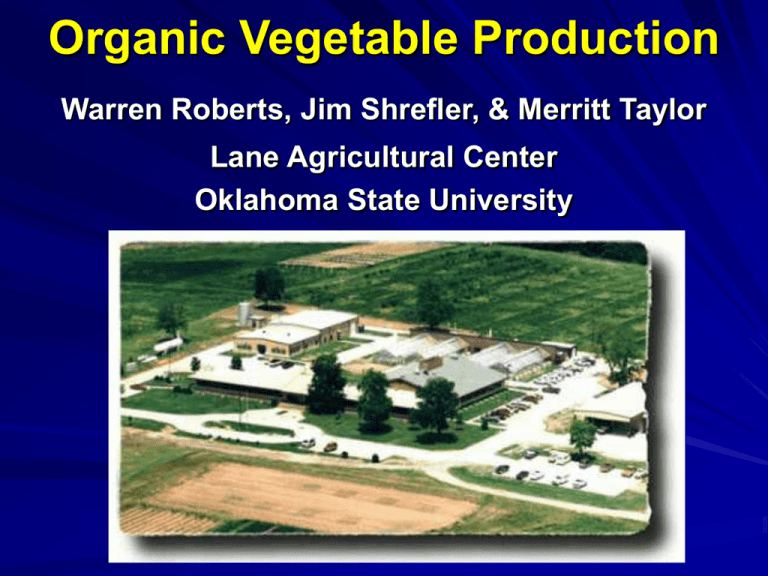
Organic Vegetable Production Warren Roberts, Jim Shrefler, & Merritt Taylor Lane Agricultural Center Oklahoma State University Certified Organic Growing U.S. Federal Guidelines - NOP A USDA Marketing Program - Approved in 2002 - Is Organic Production a New Opportunity for Growers? Where Do We Begin? What Can We Grow ? What Problems Will We Encounter? How Will We Control Problems? Is Organic Production Possible? Lane Center Organic Study Site - 2003 Previously Christmas Trees Lime Poultry Litter Approximately 2-2-2 Analysis 40-50 lbs of N per Acre 40-50 lbs of P205 per Acre 40-50 lbs of K2O per Acre Fertilizer Crops Four Year Rotation – Tomatoes – Sweet Corn – Watermelon – Southern Peas Other Organic Support Projects Four Years, Four Crops Use cover crops during winter Plant crops in the spring Turnips Crimson Clover Sweet Corn Drip irrigation Good yields most years Problems – Corn Earworm – Organic insecticides helpful – Raccoons Sweet Corn No significant numbers of foliar feeding insect pests found throughout the season Treatments: Dipel + Pyrethrum at 3 day intervals during silking stage Southern Peas Southern Peas Drip irrigation Good yields Few insect or disease problems Deer the main problem Southern Peas on June 14 Watermelon Drip, plastic mulch, transplants Variable yield results Insects & diseases critical with melons – Trap crop – Organic insecticides – Fungicides? Tomato Varieties Determinant Tomatoes Trellising Determinant Tomatoes Trellising Determinant Tomatoes Determinant Tomatoes Vegetable Weevil Vegetable Weevil Southern United States – Over-winters in soil 3/8 inch long Turnip, cabbage, tomato Damage on leaves, stems, and roots Aphids Aphids and Lady Bugs Aphids on Tomatoes Date # aphids/leaf May 27 3.93 June 11 6.93 June 17 1.00 June 25 0.13 July 9 0.00 July 14 0.57 Plants treated with azadirect (neem extract) on 6/11 and 6/14 Striped Blister Beetles Foliar Diseases Disease Control – Copper Sulfate Beet Curly Top Virus Beet Leaf Hopper What Have We Learned? Some vegetables can be Grown Organically in Oklahoma – Peas & Sweet Corn - easiest – Tomato and Watermelon Considerable risk Some critical needs General Organic Vegetable Recommendations Organic Matter Wonderful Holds Water Improves Drainage Holds Nutrients Improves Tilth Ideal Soil Raised Bed Gardening – Noble Foundation Soil Fertility and Crop Nutrients Managed through – Tillage and cultivation practices – Crop rotations – Cover crops – Animal and crop waste materials – Certain allowed synthetic materials Fertilizers Animal Manure as Fertilizer Composted or Incorporated Animal Manure Incorporated Incorporated 120 Days Prior to Harvest if Soil Contact with Edible Portion of Crop Incorporated 90 days Prior to Harvest if No Soil Contact with Edible Portion of Crop Compost Temperature 131 - 170 F 3 days Compost Temperature of 131 – 170 F 15 Days Turned a Minimum of Five Times OMRI Organic Materials Review Institute National Non-Profit Organization http://www.omri.org Fertilizers @ OMRI Aquatic Plants Ash Products Bone Meal Blood Meal Calcium Carbonate Chitin Compost Compost Tea Copper Sulfate Dolomite Feather Meal Corn Gluten Sodium Nitrate Fish Products Fertilizers @ OMRI Guano Gypsum Green-Sand Humic Acids Manure Meat By-Products Microbial Products Molasses Neem Products Peat Moss Phosphate Rock Potassium Sulfate Sugar Pest Control Primarily Management Practices – Physical, Mechanical, and Biological – Crop Rotation – Soil and Crop Nutrient Management Practices Pest Management Sanitation Measures – Remove Disease Vectors, Weed Seeds, and Habitat for Pest Organisms Selection of Plant Species and Varieties – Resistance to Pests, Weeds, and Diseases When these practices are not sufficient, a biological, botanical, or synthetic substance approved for use may be used. Materials for Pest Control Mulches Newspaper or other recycled paper, without glossy or colored inks. Elemental sulfur Soaps, insecticidal Sticky traps/barriers OMRI Listed Insect Control Bacillus thuringiensis Boric Acid Calcium Polysulfide Citronella Copper Sulfate Diatomaceous Earth Garlic Limonene Lime Sulfur Neem Products Oil Products Pyrethrum Soap Spinosad Sticky Traps Sulfur OMRI Listed Disease Control Beauveria fungus Boric Acid Calcium Polysulfide Copper Sulfate Ferric Phosphate Diatomaceous Earth Garlic Limonene (citrus oil) Hydrogen Peroxide Microbial Products Neem Plastic Mulch Potassium Bicarbonate Pseudomonas Sulfur Weed Control Mulching with Fully Biodegradable Materials Mowing Livestock Grazing Hand Weeding and Mechanical Cultivation Flame, Heat, or Electrical Means Plastic or other Synthetic Mulches: Provided, That, they are Removed from the Field at the End of the Growing or Harvest season No PVC Weed Control Best for Home Garden Weed control by hoeing Seeds @ OMRI Tomatoes – 205 Cultivars Pepper – 89 Cultivars Corn – 61 Cultivars Bean – 78 Cultivars Broccoli – 33 Cultivars Cucumber – 50 Cultivars Watermelon – 21 Cultivars Potato – 39 Cultivars Pumpkin – 27 Cultivars Squash – 82 cultivars www.lane-ag.org Unidentified Crawling Object Unidentified Crawling Object Is an invader from Germany and is indeed a beetle belonging to the family Volkswagonidae. This biotype A was once numerous but was basically eradicated by other foreign pests such as Toyotus and Hondasippius. Last known large remnant populations were in Mexico but are dying out. Biotype B is occasionally seen.
